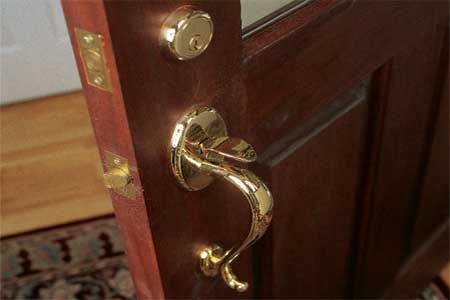Locks are the first line of defense in home security, protecting your house from unwanted visitors. According to the Bureau of Justice Statistics, about 3.7 million homes are broken into each year in the United States. To help you find the right lock for your home, we’ll detail various lock types and their features.
Types of Locks
Locks come in various types, each designed for specific uses within your home. Make sure you use the appropriate lock type for each door.
Exterior Door Locks
Exterior door locks are the most critical for home security.
- Deadbolts: These provide the highest level of security and should be on all exterior doors.
- Handle sets: These combine a deadbolt and a locking handle in one unit.
- Keyed-entry locksets: These are often used in conjunction with deadbolts for added security.
For maximum security, exterior doors should have both a deadbolt and a keyed-entry lockset or a handle set that has both features.
Interior Door Locks
Interior locks are designed to provide privacy rather than high-level security.
- Passage sets: Non-locking knobs or levers used for closets and hallways.
- Privacy locksets: Used for bedrooms and bathrooms, these can be locked from the inside but usually have an emergency release mechanism.
Interior locks are generally less expensive than exterior locks, though high-end models can be pricier. These locks typically focus on convenience and accessibility.
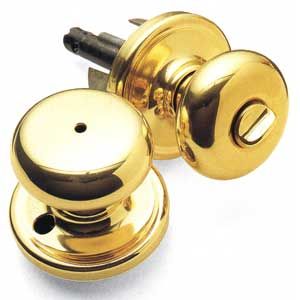
Specialty Locks
These locks have specific functions for unique applications:
- Cabinet locks: Used to secure cabinets containing valuables or potentially dangerous items.
- Padlocks: Portable locks used for sheds, gates, and storage units.
- Window locks: Add an extra layer of security to windows.
Understanding Lock Grades and Security Ratings
The American National Standards Institute (ANSI) and Builders Hardware Manufacturers Association (BHMA) have established the following grading system for locks:
- Grade 1: Highest security, typically used in commercial settings but excellent for residential use.
- Grade 2: High security, used in many homes on exterior doors.
- Grade 3: Basic security, reasonable for interior doors.
When selecting locks, particularly for exterior doors, aim for Grade 2 or higher. Be wary of marketing claims touting “Grade 1 features” without an actual Grade 1 rating for the entire lock.
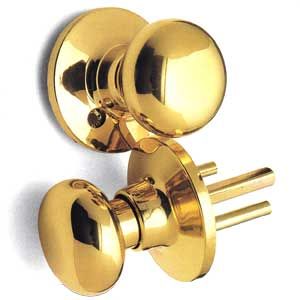
Key Components of a Lock System
Understanding the parts of a lock can help you make informed decisions when shopping for a new lock or maintaining existing ones.
Cylinders and Pins
The cylinder is the core of the lock where the key is inserted. It contains a series of pins that must align correctly for the lock to open. Higher-quality locks often feature:
- Hardened steel pins for increased durability and pick resistance.
- Six-pin systems, which are harder to pick than five-pin systems.
Bolts and Latches
Bolts and latches are the parts that extend into the door frame to secure the door. Deadbolts should have a minimum 1-inch throw (extension into the frame) for maximum security. Look for dead-locking latch bolts on keyed-entry locksets to prevent credit card jimmying. The strength and design of these components determine the lock’s resistance to forced entry.
Strike Plates
The strike plate is the metal plate on the door frame that the bolt or latch extends into. Choose heavy-gauge steel or brass strike plates, and secure them with 3-inch screws that penetrate the door frame and wall studs for added strength.
Deadbolt Locks: The Ultimate in Door Security
Deadbolts are common for exterior door security systems. They offer better protection than spring-loaded locks, primarily because of their robust construction and locking mechanism.
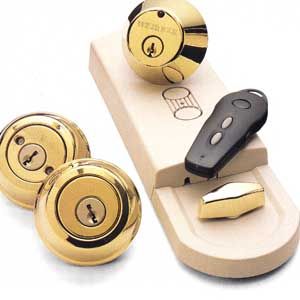
Single-Cylinder vs. Double-Cylinder Deadbolts
- Single-cylinder deadbolts have a key cylinder on the outside and a thumb turn on the inside.
- Double-cylinder deadbolts require a key on both sides, which increases security but potentially poses a safety risk during emergencies.
Many building codes require single-cylinder units for safety reasons. If you go for a double-cylinder deadbolt, keep a key near the door for quick exits.
Features To Look for in Quality Deadbolts
When shopping for deadbolts, we recommend prioritizing these features:
- Forged, solid-brass plug and cylinder
- Free-spinning, sawproof, hardened-steel pin in the bolt
- Grade 2 or Grade 1 ANSI/BHMA rating
- Housing that protrudes into the door face
- Large, easy-to-use interior turnpiece
- Minimum 1-inch throw bolt
- Six-pin keying system
Some innovative deadbolts even have additional features like remote control operation or built-in lighting for easier nighttime use.
Keyed-Entry Locksets and Handle Sets
Keyed-entry locksets and handle sets work in tandem with deadbolts to secure exterior doors. They serve as the primary access point and should therefore offer robust security features.
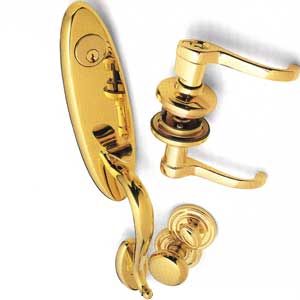
Essential Features for Maximum Security
Look for these features in keyed-entry locksets and handle sets:
- Dead-locking latch bolt to prevent credit card jimmying
- Dual-torque springs to prevent sagging
- Emergency-exit feature allowing the door to open from inside even when locked
- Grade 2 security rating
- Heavy-duty strike plate with long screws
- Lifetime tarnish-free finish and mechanical warranty
- Protective shroud behind the decorative rose
- Six-pin keying system
- Universal keying compatibility
For added efficiency and safety, consider handle sets with interconnected locks that allow you to unlock both the main lock and deadbolt with a single interior motion.
Smart Locks
Smart locks are revolutionizing home security by offering keyless entry and remote access control. These advanced systems combine security with utility and are becoming increasingly popular among homeowners.
Benefits of Smart Locks
- Access logs to track who enters and exits
- Integration with home automation systems
- Keyless entry using PIN codes, smartphone apps, or biometrics
- Remote locking and unlocking
- Temporary access codes for guests or service providers
By eliminating the need for physical keys, smart locks reduce the risk of lost or stolen keys and allow for more flexible access control.
Potential Drawbacks and Considerations
- Battery dependence (though most have backup key options)
- Cybersecurity concerns
- Higher cost compared to traditional locks
- Reliance on technology and potential for technical issues
When considering smart locks, weigh the convenience against potential security risks. Make sure you choose a reputable brand with strong encryption and security features. Staying informed about the latest updates and advancements in smart lock technology can help you mitigate potential risks.
DIY Lock Installation and Maintenance
While complex lock installations are best left to professionals, many homeowners can handle basic lock replacements and maintenance. Tackling these projects yourself can save you money and provide a sense of accomplishment.
Tools You’ll Need
- Chisel
- Drill with various bits
- Level
- Pencil
- Screwdriver set
- Tape measure
Step-by-Step Lock Installation Guide
- Position the template: Most doorknobs are 34–38 inches high, with deadbolts 6–12 inches above that. Decide for yourself what height is comfortable. When drilling new holes, tape the manufacturer’s template in place with the lockset centerline at the desired height. Determine the backset—the distance from the door edge to the knob centerline—and use the corresponding template marks. The backset can be 2 3/8 or 2 3/4 inches; many locksets accommodate both. Then, drill 1/8-inch pilot holes through the door to center the 2 1/8-inch hole saw. At the door edge, use the template to drill a 2-inch-deep pilot hole for drilling for the strike or bolt.
- Drill the door face and mark the jamb: Using a drill with a bubble level or a torpedo level taped on top, drill halfway through the door from each side with the hole saw to prevent blowout splintering. Then mark the doorjamb for the strike plate by closing the door, inserting a nail from inside the 2 1/8-inch hole through the strike pilot hole and pushing it into the jamb.
- Drill the jamb and door edge: With the nail mark as an indicator, drill a 5/8-inch-deep hole for the strike or a 1-inch-deep hole for the deadbolt using the 1-inch spade bit (sizes vary, so check instructions). In the door edge, use the pilot hole to guide a 1-inch spade bit and drill through to the large hole where the cylinder will sit.
- Chisel the jamb and door edge: Hold the latch assembly up to the door edge and score its outline deeply with a utility knife. Do the same for the strike plate on the doorjamb. Then, score the wood to be removed at 1/4-inch intervals with a chisel, removing enough wood so the strike box sits flush with the door edge and the strike plate sits flush with the doorjamb.
- Install the hardware: Insert the latch assembly in the hole you drilled in the door edge and fasten it with screws after predrilling for them. Next, insert the handle set and cylindrical lock or deadbolt assembly, so the spindle or tailpiece aligns with the strike assembly. Typically, screws pass through the door to hold the two lockset pieces together on opposite sides. For security, be sure exposed screwheads are on the interior side of the lockset.
For more detailed information on lock installation, check out our guide to rekeying a lock yourself.
Common Lock Problems and How To Fix Them
Regular maintenance, including cleaning and lubricating, can prevent many common lock issues. However, you may still encounter problems. Identifying and addressing these issues quickly can prevent more significant problems down the line.
- Broken keys: Extract with needle-nose pliers, or seek professional help.
- Frozen locks: Use a lock de-icer or heat the key before inserting.
- Loose doorknob: Tighten set screws or replace worn components.
- Misaligned strike plate: Adjust or reinstall the plate.
- Sticky locks: Clean and lubricate with graphite powder.
Improving Your Home’s Overall Security in Addition to Locks
While locks are the most important part of a secure home, combining physical security measures with technological solutions will create a robust defense against potential threats.
Consider taking the following additional security measures:
- Install a home security system with cameras and alarms.
- Join or start a neighborhood watch program.
- Reinforce door frames and windows.
- Trim bushes near entry points to eliminate hiding spots.
- Use motion-activated exterior lighting.
